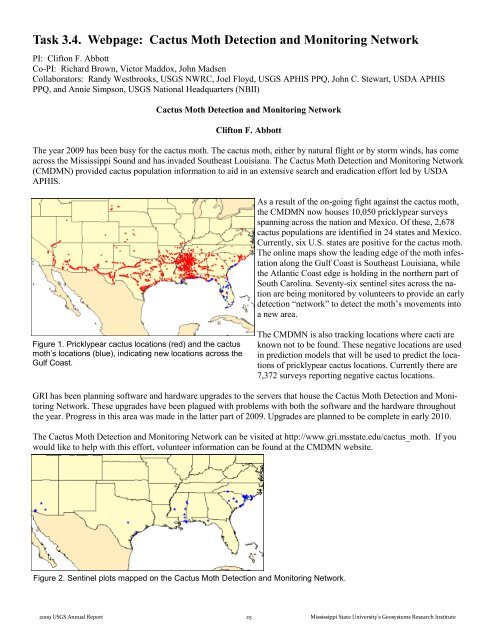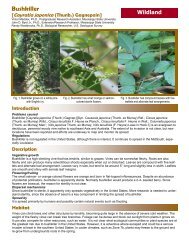RATopic1_95 - Geosystems Research Institute - Mississippi State ...
RATopic1_95 - Geosystems Research Institute - Mississippi State ...
RATopic1_95 - Geosystems Research Institute - Mississippi State ...
Create successful ePaper yourself
Turn your PDF publications into a flip-book with our unique Google optimized e-Paper software.
Task 3.4. Webpage: Cactus Moth Detection and Monitoring Network<br />
PI: Clifton F. Abbott<br />
Co-PI: Richard Brown, Victor Maddox, John Madsen<br />
Collaborators: Randy Westbrooks, USGS NWRC, Joel Floyd, USGS APHIS PPQ, John C. Stewart, USDA APHIS<br />
PPQ, and Annie Simpson, USGS National Headquarters (NBII)<br />
Cactus Moth Detection and Monitoring Network<br />
Clifton F. Abbott<br />
The year 2009 has been busy for the cactus moth. The cactus moth, either by natural flight or by storm winds, has come<br />
across the <strong>Mississippi</strong> Sound and has invaded Southeast Louisiana. The Cactus Moth Detection and Monitoring Network<br />
(CMDMN) provided cactus population information to aid in an extensive search and eradication effort led by USDA<br />
APHIS.<br />
As a result of the on-going fight against the cactus moth,<br />
the CMDMN now houses 10,050 pricklypear surveys<br />
spanning across the nation and Mexico. Of these, 2,678<br />
cactus populations are identified in 24 states and Mexico.<br />
Currently, six U.S. states are positive for the cactus moth.<br />
The online maps show the leading edge of the moth infestation<br />
along the Gulf Coast is Southeast Louisiana, while<br />
the Atlantic Coast edge is holding in the northern part of<br />
South Carolina. Seventy-six sentinel sites across the nation<br />
are being monitored by volunteers to provide an early<br />
detection “network” to detect the moth‟s movements into<br />
a new area.<br />
Figure 1. Pricklypear cactus locations (red) and the cactus<br />
moth’s locations (blue), indicating new locations across the<br />
Gulf Coast.<br />
The CMDMN is also tracking locations where cacti are<br />
known not to be found. These negative locations are used<br />
in prediction models that will be used to predict the locations<br />
of pricklypear cactus locations. Currently there are<br />
7,372 surveys reporting negative cactus locations.<br />
GRI has been planning software and hardware upgrades to the servers that house the Cactus Moth Detection and Monitoring<br />
Network. These upgrades have been plagued with problems with both the software and the hardware throughout<br />
the year. Progress in this area was made in the latter part of 2009. Upgrades are planned to be complete in early 2010.<br />
The Cactus Moth Detection and Monitoring Network can be visited at http://www.gri.msstate.edu/cactus_moth. If you<br />
would like to help with this effort, volunteer information can be found at the CMDMN website.<br />
Figure 2. Sentinel plots mapped on the Cactus Moth Detection and Monitoring Network.<br />
2009 USGS Annual Report 25 <strong>Mississippi</strong> <strong>State</strong> University’s <strong>Geosystems</strong> <strong>Research</strong> <strong>Institute</strong>




